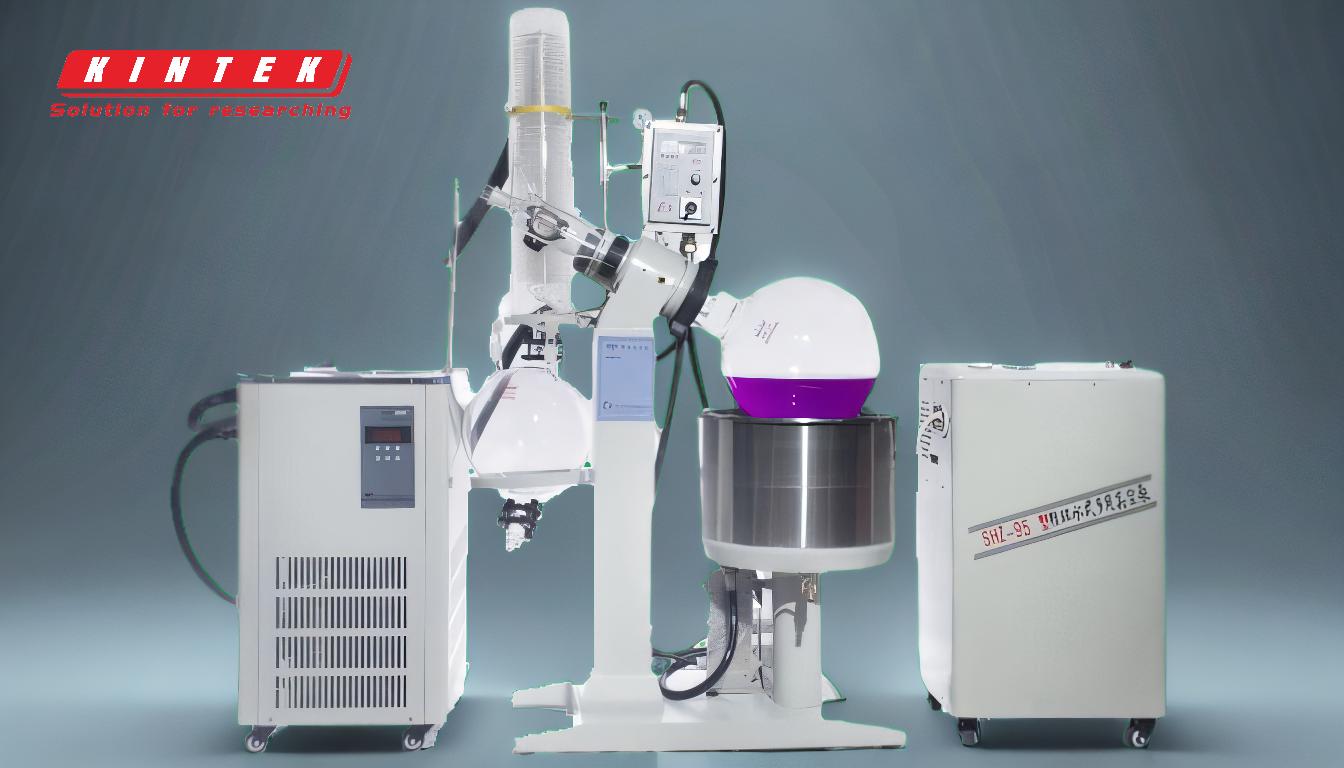A rotary evaporator removes solvents through a combination of reduced pressure, controlled heating, and mechanical rotation. The process begins by placing the sample in a round-bottomed flask, which is then immersed in a heated water or oil bath. The pressure inside the system is reduced using a vacuum pump, lowering the solvent's boiling point. As the flask rotates, the solvent forms a thin film on the inner surface, increasing its surface area and accelerating evaporation. The solvent vapors are then condensed in a chilled glass condenser and collected in a separate flask, leaving the concentrated sample behind. This method is efficient, gentle, and widely used in laboratories for solvent removal.
Key Points Explained:

-
Reduction of Pressure:
- A vacuum pump is used to lower the pressure inside the rotary evaporator.
- Lower pressure reduces the boiling point of the solvent, allowing it to evaporate at a lower temperature.
- This is crucial for heat-sensitive compounds that might degrade at higher temperatures.
-
Heating the Sample:
- The sample is placed in a round-bottomed flask, which is immersed in a heated water or oil bath.
- The heat provides the necessary energy for the solvent to evaporate, even at reduced pressures.
- The temperature of the bath is carefully controlled to avoid overheating the sample.
-
Rotation of the Flask:
- The flask is rotated at a constant speed, typically between 50 to 200 RPM.
- Rotation spreads the sample into a thin film on the inner surface of the flask, significantly increasing the surface area.
- This maximizes the rate of evaporation by exposing more of the solvent to the reduced pressure and heat.
-
Evaporation and Vapor Formation:
- As the solvent evaporates, it forms vapors that rise from the surface of the liquid.
- The reduced pressure and heat ensure that the solvent evaporates efficiently, even at lower temperatures.
-
Condensation of Solvent Vapors:
- The solvent vapors travel through the system and enter a glass condenser.
- The condenser is chilled, often using a cooling fluid like water or a refrigerant, which causes the vapors to re-condense into a liquid.
- The condensed solvent drips down into a separate collection flask.
-
Separation of Solvent and Sample:
- The solvent is collected in the receiving flask, while the concentrated sample remains in the original round-bottomed flask.
- This separation is crucial for isolating the desired compound or concentrating the sample for further analysis or use.
-
Factors Influencing Evaporation Rate:
- Rotation Speed: Faster rotation increases the surface area of the solvent, speeding up evaporation.
- Bath Temperature: Higher temperatures provide more energy for evaporation but must be balanced to avoid sample degradation.
- Condenser Temperature: Lower condenser temperatures improve the efficiency of vapor condensation.
- Vacuum Pressure: A stronger vacuum lowers the boiling point further, allowing for faster and more efficient solvent removal.
-
Applications and Advantages:
- Rotary evaporators are widely used in chemistry, pharmaceuticals, and food science for solvent removal, concentration, and purification.
- The method is gentle, efficient, and suitable for heat-sensitive materials.
- It allows for the recovery of solvents, which can be reused, making it an environmentally friendly option.
By understanding these key points, one can appreciate the sophisticated yet straightforward mechanism by which a rotary evaporator removes solvents, making it an indispensable tool in modern laboratories.
Summary Table:
| Key Component | Function |
|---|---|
| Reduced Pressure | Lowers solvent boiling point, enabling evaporation at lower temperatures. |
| Controlled Heating | Provides energy for evaporation while protecting heat-sensitive samples. |
| Mechanical Rotation | Forms a thin film, increasing surface area for faster evaporation. |
| Condenser | Chills solvent vapors, converting them back to liquid for collection. |
| Applications | Solvent removal, sample concentration, and purification in various fields. |
Discover how a rotary evaporator can streamline your lab processes—contact us today for expert advice!









